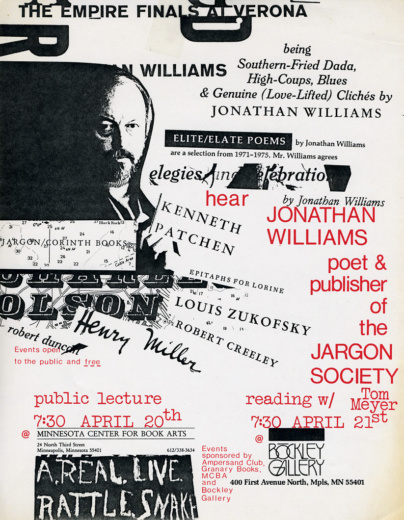
Dale Smith
Devotion to “The Strange”
Jonathan Williams and the Small Press
1
For more than fifty years Jonathan Williams published from his home in North Carolina an extraordinary number of poets and writers, many claiming diverse affiliations to the poetic tribes that compose the heart of the New America poetry. The Jargon Society, a now-legendary small publisher, proved what single-mindedness and determination could accomplish in the world of American letters. Williams’ exceptional legacy as publisher, provocateur, poet, essayist, and photographer maps out numerous possibilities available to other artists intent on keeping alive the various folkways and urbane intelligences that commingle in the local attention of the artist. In many ways he established a model for how to build a community of writers from the ground up. With James Laughlin, Lawrence Ferlinghetti, Amiri Baraka, Diane di Prima, and many others, Williams contributed to the fertile and energetic continuation of North American literature in a period of increasing cultural consolidation by the New York publishing industry. As a model of what a publisher can be, Williams certainly ranks among our greatest.
2
Through his work with the Jargon Society, Williams introduced many authors to print, including James Broughton, Basil Bunting, Robert Creeley, Robert Duncan, Denise Levertov, Paul Metcalf, Lorine Niedecker, Charles Olson, and Louis Zukofsky. His appetite for little known writers and photographers revealed him to be a man driven by a curiosity to possess perspectives formed in hidden details, exotic oddities, and introspective visions. His search for the hidden and over-looked spread from his publishing life into other orders of attention as well. Such a need to apprehend phenomenal details and to make them available to others should be instructive to any DIY publisher today. Instead of looking for strategically fashionable exemplars of the arts, Williams expressed preference for the unknown or forgotten. Not only did he publish the likes of Wisconsin poet Lorine Niedecker, practically unknown in the 1960s when Williams encountered her work, and Alfred Starr Hamilton, a New Jersey poet who lived much of his life in a Montclair boarding house, he looked at the world with a similar appetite for the disclosure of unknown things. In “The Poetry of Work,” he writes:
3
On a Pennsylvania dresser in my workroom in Highlands, North Carolina, I have six pots and vases: a Ch’ien Lung mirror-black; a tall Ming celadon; an alchemical form by M. C. Richards; a small, spotted Bernard Leach celadon; a plump, white piece by Toshiko Takaezu; and a polished black piece from the Santa Clara pueblo with eagle-feather design by Camillo Tafoya; on a wall behind them is a portrait of Charles Edward Ives, by W. Eugene Smith. A small quotation from the Shakers is pinned next to it: “No vice is with us the less ridiculous for being in fashion.”

No comments:
Post a Comment